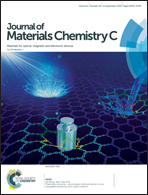A conjugated microporous polymer film fabricated by in situ electro-chemical deposition as a hole transporting layer in organic photovoltaics†
Abstract
Conjugated microporous polymers (CMPs) are a unique class of polymers that consist of an extended π-conjugated backbone and reactive side groups. Owing to the non-planar configuration of the monomer, these polymers form a solid 3D crosslinked framework that facilitates charge transport in the polymers. Herein, we report the synthesis of CMP films polymerized by electrochemical deposition and their use as hole transporting layers in organic photovoltaics (OPVs). With this strategy, the thickness could be precisely controlled by the scan cycle. The pH neutral CMP film avoids the acidity of the commercial PEDOT:PSS, which is the most commonly used hole transporting material in OPVs. With CMP films, we achieve comparable device performances with PEDOT:PSS containing devices based on PTB7-Th:PC71BM. Afforded by the described electrochemical approach, the amounts of materials needed to reach a target film thickness can be favorably saved with respect to those with spin-casting, which provides an opportunity for reducing the cost of OPVs.



 Please wait while we load your content...
Please wait while we load your content...